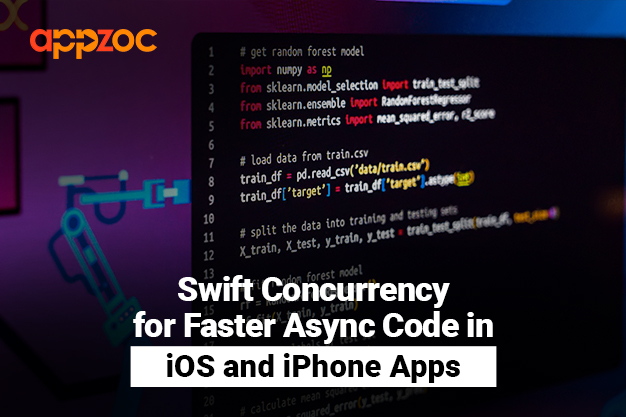
Flutter
Make the most of this cutting-edge technology by developing apps quickly! Our Flutter solutions have amazing features that can be used to create sleek, high-performance apps that can scale seamlessly across platforms.

In the ever-evolving landscape of iOS app development, the need for speed, responsiveness, and efficiency is paramount. Users demand applications that not only look good but also perform seamlessly. With Swift Concurrency, a powerful feature introduced in Swift 5.5, iOS app developers can achieve just that. In this blog post, we will explore how Swift Concurrency enhances the development of iOS apps, making them faster and more responsive, and why it’s a game-changer for iOS app development in regions like Kerala and Bangalore.
Before delving into Swift Concurrency, let’s grasp the importance of concurrency in iOS app development. Concurrency refers to the ability to execute multiple tasks simultaneously, making the most of multicore processors. In the context of iOS apps, this means running tasks in the background while keeping the user interface responsive.
Without proper concurrency management, an app may become unresponsive when performing resource-intensive tasks, such as downloading data, processing images, or fetching information from a remote server. This can result in a poor user experience and potential user abandonment.
Traditionally, iOS developers had to rely on mechanisms like Grand Central Dispatch (GCD) and completion handlers to manage asynchronous operations. While effective, these approaches could be challenging to implement correctly and were prone to bugs, such as race conditions and deadlocks.
Furthermore, debugging asynchronous code could be a daunting task, making it harder for developers to identify and fix issues quickly. This led to longer development cycles and potentially slower apps.
Swift Concurrency addresses these challenges head-on. It introduces a set of language features that make writing asynchronous code more natural, readable, and less error-prone. Let’s explore some of the key features that Swift Concurrency brings to iOS app development.
1.Async and Await Keywords: With Swift Concurrency, you can use the async and await keywords to mark asynchronous functions and points in your code where asynchronous operations are called. This makes it clear which parts of your code are asynchronous and simplifies the control flow.
2.Structured Concurrency: Swift introduces structured concurrency, which helps manage the lifecycle of concurrent tasks. This ensures that tasks are properly started, executed, and awaited, reducing the risk of memory leaks and unexpected behavior.
3.Task API: The Task API provides a flexible and powerful way to work with concurrent tasks. You can create and control tasks, cancel them when necessary, and await their results.
4.Cancellation: Swift Concurrency makes it easier to handle task cancellation gracefully, improving resource management and responsiveness.
5.Actor Model: Actors are a new concurrency primitive in Swift that allows you to encapsulate mutable state and ensure safe concurrent access to it. This simplifies the management of shared data and reduces the likelihood of data races.
Kerala, known for its thriving IT sector and a burgeoning community of iOS app developers, can significantly benefit from Swift Concurrency. Here’s how:
1.Faster Development: Swift Concurrency simplifies asynchronous code, reducing the time spent on debugging and troubleshooting. Developers in Kerala can accelerate their app development timelines, delivering high-quality apps more efficiently.
2.Improved User Experience: With the ability to write responsive apps more easily, Kerala-based developers can create apps that provide an enhanced user experience. Whether it’s a local tourism app or a healthcare solution, user satisfaction is crucial, and Swift Concurrency can help achieve it.
3.Competitive Advantage: By adopting the latest iOS development practices, developers in Kerala can stay competitive in the global app market. Apps that perform well and respond quickly to user interactions are more likely to succeed.
Bangalore, often referred to as the Silicon Valley of India, is a hub for technology companies and startups. Here’s how Swift Concurrency can boost iOS app development in this bustling city:
1.Tech Innovation: Bangalore’s tech-savvy culture is always hungry for innovation. Swift Concurrency enables developers to experiment with cutting-edge features and build apps that push the boundaries of what’s possible on the iOS platform.
2.Scalability: For startups and growing companies in Bangalore, scalability is a key concern. Swift Concurrency simplifies the development of scalable, concurrent systems, ensuring that apps can handle increased workloads as they grow.
3.Global Reach: Apps developed in Bangalore often have a global user base. Swift Concurrency helps developers create apps that cater to users worldwide, regardless of their location or device.
Also Read:Submitting Your iOS App to The App Store: A Start to Finish Guide
As an iOS app developer in Kerala, Bangalore, or anywhere else, embracing Swift Concurrency can be a game-changer for your projects. To get started, make sure you’re using the latest version of Xcode, which includes Swift 5.5 and its concurrency features.
Learn the Basics: Familiarize yourself with the async and await keywords, structured concurrency, and the Task API. Swift’s official documentation and online tutorials can be valuable resources.
Practice: Experiment with Swift Concurrency in your iOS projects. Start with small tasks to get comfortable with the new features.
Debugging: Swift Concurrency makes debugging easier, but you should still be prepared to troubleshoot any issues that arise in your code.
Stay Updated: Swift is continuously evolving, and new concurrency features or improvements may be introduced in future versions. Stay up to date with the latest developments to leverage the full power of Swift Concurrency.
Swift Concurrency is a game-changer for iOS app development, offering developers in Kerala, Bangalore, and around the world a more efficient and effective way to write asynchronous code. By simplifying concurrency management, Swift Concurrency leads to faster development, improved user experiences, and a competitive edge in the dynamic world of iOS app development. Embrace Swift Concurrency, and watch your iOS apps become faster, more responsive, and better-received by users.